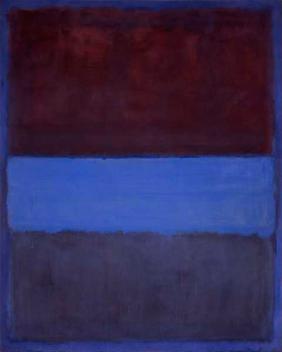Abstract Expressionism
(1940s)
- post–World War II art movement in American painting, developed in New York in the 1940s, but some associate it with German Expressionism in the 1920s-30s
- can be seen as a rejection of art as
- the artist's own emotional expressions, the process of painting, and action over the canvas all becomes the art itself - the human aspect of painting, hence the term 'action painting'
- Although it is true that spontaneity or the impression of spontaneity characterized many of the abstract expressionists works, most of these paintings involved careful planning
- its brush stokes revealed the artist's process. This process is the subject of the art itself: conscious control VS. spontaneous automation
- unconventional application of paint, usually without a recognizable subject, involving striking colors, smearing, slathering, and flinging paint and brushstrokes onto the canvas
- No subject matter within the painting. The action of painting itself is the subject matter - let the paint be paint, let the painting be painting
- Later even the titles disappear, with paintings being named as merely by numbers
- has a reputation of being rebellious, anarchic, idiosyncratic and even nihilistic
- Abstract Expressionism's physicality comes from explorations of inner turmoil and anxiety. Some of this distress came from exposure to the disturbing reports of horrors and pain endured during World War II. Some of the distress came from the threat of a nuclear holocaust as the Cold War heated up
- Notable artists: Jackson Pollock, Hans Hofman, Franz Kline, Mark Rothko, Arshile Gorky, Mark Tobey, Adolf Gottlieb
Simplex Munditis by Hans Hofmann (1962) Painting Number 2 by Franz Kline (1954)
 No. 1 by Jackson Pollock (1950)
No. 1 by Jackson Pollock (1950)- Pollock is known for painting (dripping, smashing, splattering paint) on a horizontally placed canvas, thus providing a horizontal arena
- The distribution of the colors across the space of the canvas also reveals a process of both order and spontaneity
- The canvas is not a space or a window, but an arena for an event to take place.

Color Field Painting
- a style of abstract painting that emerged in New York in the 50s-60s
- characterized by simple blocks (or fields) of colors on the canvas
- Color is freed from context and becomes the subject of art itself
- "We favor the simple expression of complex thought. We are for the large shape because it has the impact of the unequivocal. We wish to reassert the picture plane. We are for flat forms because they destroy illusion and reveal truth." ~Rothko, 1943

Magenta, Black, Green on Orange by Mark Rothko (1947) No. 14 by Mark Rothko (1960)
Sources:
http://en.wikipedia.com
http://www.artyfactory.com/
http://www.arthistoryarchive.com/
http://arthistory.about.com/
Jon Anderson (Biola University): lecture on Postmodern Strategies: the Canvas as an Arena: Jackson Pollock in
http://arthistory.about.com/
Jon Anderson (Biola University): lecture on Postmodern Strategies: the Canvas as an Arena: Jackson Pollock in






